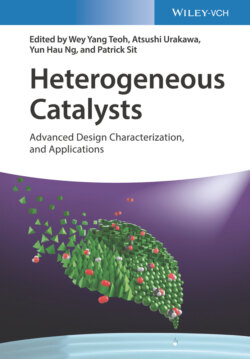Читать книгу Heterogeneous Catalysts - Группа авторов - Страница 40
3.2.4.1 Combined Electrophoretic Deposition–Anodization (CEPDA) Approach
ОглавлениеCombined electrophoretic deposition–anodization (CEPDA) is a combined electrochemical process that developed to allow the simultaneous anodic growth of metal oxide and the electrophoretic‐driven deposition of reduced graphene oxide (RGO) on the resulting anodic oxide [18]. Metallic foil is employed as the anode in a typical anodization setup as shown in Figure 3.7. Formation of TiO2 nanotube (TNT) arrays following the typical anodization route is expected. However, the organic electrolyte of this anodizing setup is suspended with particles/flakes of RGO with negative surface charge. Within the anodization duration, electrophoretic forces drive the negatively charged RGO to the TiO2 anode to form TiO2–RGO composite that find uses in photocatalytic reactions. The RGO deposited on TNTs using CEPDA method has a stronger physical interaction between host and guest compared with the typical coating techniques such as spin, drop, and dip coating. This is a demonstration of preparing composite materials by combining two electrochemical working principles in a single experimental process. Otherwise, this kind of composite thin film can be prepared by multistep process. In this combinatory method, both the growth of oxide and its integration with secondary component can take place simultaneously.
Figure 3.7 Schematic illustration of the apparatus for combined electrophoretic deposition–anodization (CEPDA) approach in the preparation of TiO2 nanotube (TNT)–reduced graphene oxide (RGO) composite.
Source: Yun et al. 2012 [18]. Reproduced with permission of Royal Society of Chemistry.
(See online version for color figure).
Although anodization is, in general, limited to the synthesis of simple oxide thin film, by combining the as‐anodized thin film (before rigid crystallization) with hydrothermal/solvothermal treatment, transformation of the simple metal oxide into complex ternary oxide is possible [18, 33, 34]. Depending on the metallic substrate, bare anodization process usually yields the metal oxide with amorphous phase or partially crystalline structure. Subsequent annealing at elevated temperature is needed to transform the as‐anodized films into well‐crystallized metal oxide that find applications in various reactions. This intermediate state of as‐anodized film offers the possibility to further engineering their composition for final product. For example, upon anodization of tungsten foil, the formed layer is hydrated WO3 (WO3·2H2O) with loosely packed structure. Subjecting this as‐anodized WO3·2H2O film into a hydrothermal treatment containing bismuth species (Bi2O2)2+ forces the interstitial water molecules to be replaced by (Bi2O2)2+. Crystallization process takes place during the hydrothermal treatment, and bismuth tungstate (Bi2WO6) thin film is obtained. With proper control, the rate and the depth for the insertion of Bi cations into host material (example is WO3) can be tuned. As a result, catalytic thin film with two Bi as dopant is made. More interestingly, the concentration of dopant (not limited to Bi) indicates gradient across interfaces. This gradient concentration has important and constructive impact on charge transfer. The combination of anodization with hydrothermal treatment has been proven applicable to prepare different types of ternary oxide films. However, detailed procedures should be strictly considered in this combinatory method. The successful transformation of simple metal oxide into ternary or complex metal oxide is based on the relatively amorphous nature of the as‐anodized metal oxide film. Such transformation is not likely when the highly rigid or crystalline anodized films are employed due to the limited rearrangement of the lattice structure.
